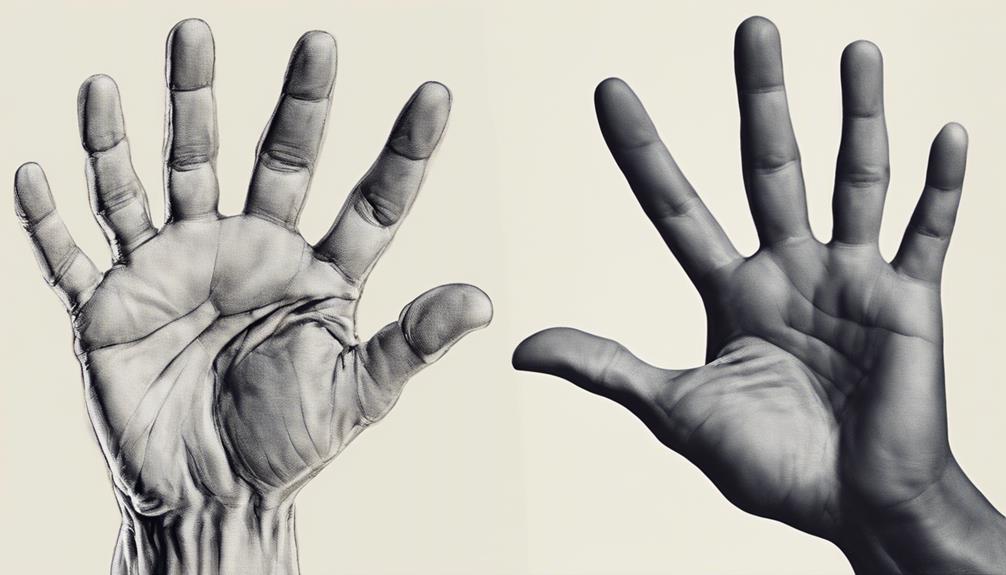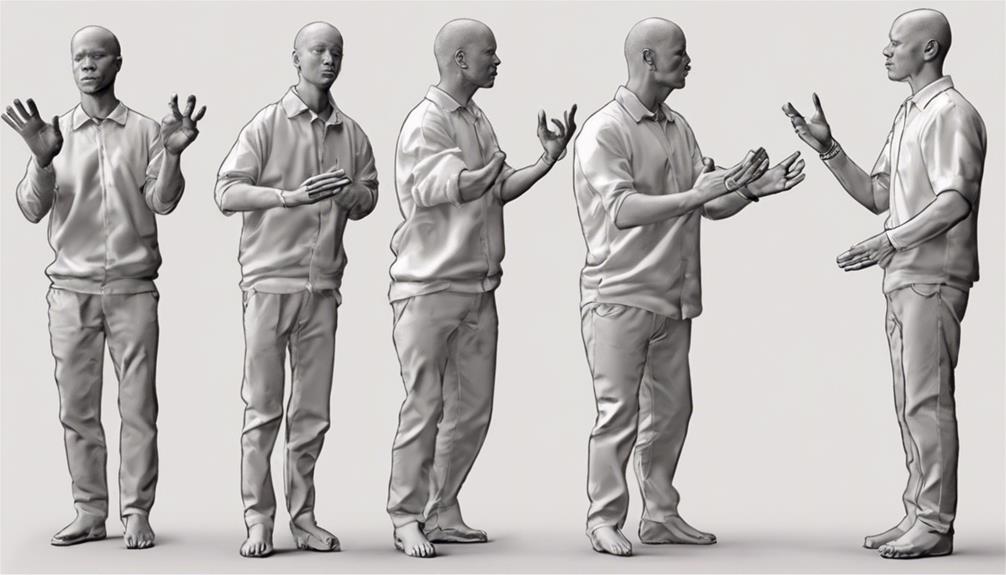Mastering the M sign in sign language may be challenging initially due to the hand positioning. Yet, with practice and guidance, it will become more natural.
Exploring the intricacies of this particular sign provides a gateway to broader language proficiency. By delving into the nuances of hand placement and understanding the various contexts in which the M sign is used, a deeper appreciation for sign language communication can be achieved.
Key Takeaways
- Understanding correct hand formation is crucial for clear communication.
- The M sign signifies various words and concepts in sign language.
- Practice integrating the M sign in sentences for fluency.
- Consistent repetition and visual aids enhance proficiency in signing the letter M.
Importance of the M Sign
Mastering the M sign in sign language is crucial for effective communication and language proficiency in the Deaf community. The M sign plays a significant role in spelling words, names, and expressing various concepts in American Sign Language (ASL).
It's essential to understand the correct hand shape and movement, particularly with the dominant hand, to ensure accurate signing and enhance communication clarity and fluency during sign language conversations. Proficiency in signing the M letter not only opens up opportunities for effective communication with the Deaf community but also fosters a deeper connection and understanding within the community.
Regular practice of the M sign is key to improving muscle memory, leading to consistent and clear signing abilities. By mastering the M sign, individuals can contribute to creating an inclusive and accessible environment for all members of the Deaf community, promoting better communication and understanding.
Correct Hand Formation for M Sign

When forming the M sign in American Sign Language (ASL), ensure your thumb is tucked between your pinky and ring finger while curling the remaining fingers into your palm. The knuckles on your pointer, middle, and ring fingers should resemble the humps of the letter M when signing. Accurate hand positioning is essential for clarity when signing the letter M in ASL. Practice visualizing the cursive letter M to help you remember the correct hand formation for signing. Consistent practice and attention to hand placement will lead to mastery of the M sign in ASL.
| Hand Formation for M Sign |
|---|
| Thumb tucked between pinky and ring finger |
| Curl remaining fingers into palm |
| Knuckles of pointer, middle, and ring fingers resemble M |
| Accurate hand positioning is crucial |
| Practice visualizing cursive M for accuracy |
Common Meanings of the M Sign
Exploring the various meanings of the 'M' sign in ASL broadens our understanding of its versatile applications in sign language communication. The 'M' sign can signify words like 'mom,' 'more,' or 'music,' making it a vital part of daily conversations. When fingerspelling, this sign is commonly used for names or words beginning with the letter 'M.' Additionally, in ASL, the 'M' sign can convey concepts such as 'many,' 'middle,' or 'Monday,' providing a way to express a range of ideas succinctly.
Interpreting the intended meaning of the 'M' sign often relies on understanding the context of the conversation. This sign's flexibility allows signers to communicate efficiently and effectively by incorporating various meanings into their discussions. Learning the different interpretations of the 'M' sign not only enriches sign language users' vocabulary but also enhances their ability to express themselves clearly. Mastering the nuances of the 'M' sign opens up a world of communication possibilities in sign language.
Using the M Sign in Sentences

Incorporating the 'M' sign into sentences accurately represents the letter in ASL, enhancing communication fluency.
When using the 'M' sign, remember to extend three fingers while the others are folded into your palm.
Placing the hand near the mouth with the fingers pointing outward helps emphasize the sign within the sentence structure.
This sign is versatile and can be seamlessly integrated into various conversations to convey different meanings.
By practicing the 'M' sign in different contexts, you can reinforce its significance and application in sign language.
Building sentences that showcase the correct placement of the 'M' sign won't only improve your understanding but also enhance your proficiency in ASL communication.
Utilizing the 'M' sign fluidly within your sentences is key to developing fluency and confidence in using sign language effectively.
Through interactive exercises that incorporate the 'M' sign, you can further enhance your understanding and usage of this important ASL symbol.
Practice Exercises for Mastering M Sign
Let's delve into practical exercises for mastering the M sign in American Sign Language.
To start, position your thumb between the pinky and ring finger, while curling the other fingers into your palm. Ensure to bend the knuckles on your pointer, middle, and ring fingers to create the three distinctive humps of the M sign.
Utilize visual aids such as flashcards or instructional videos to reinforce the correct hand movements needed for forming the M sign accurately. Consistent repetition of the M sign gesture is crucial for enhancing muscle memory and precision.
Engage in interactive exercises and drills that focus on signing the letter M in ASL to further develop proficiency. By concentrating on the alignment of your pinky and ring finger, you can improve your fluency in producing the M sign with clarity and confidence.
Practice diligently and watch your signing skills flourish.
Frequently Asked Questions
How Do You Do the M in Sign Language?
When signing the letter M in American Sign Language, we tuck our thumb between the pinky and ring finger while curling the remaining fingers into the palm. Ensure the knuckles on the pointer, middle, and ring fingers resemble the humps of the letter M for accuracy.
It's beneficial to pair the sign with the corresponding sound and use alphabet magnets or flashcards for practice. Consistent and correct practice is key to mastering this ASL letter.
How Do You Sign the I'm Learning Sign?
We express our ongoing journey of learning by combining 'I,' 'learn,' and 'ing' signs in sign language. This fusion captures the essence of continuous growth and knowledge acquisition.
How to Speak Sign Language Fluently?
To speak sign language fluently, we need consistent practice, feedback from skilled signers, and access to educational resources like online courses. Engaging in conversations with Deaf individuals is crucial for improving proficiency. Start by mastering basic signs and gradually progress to more complex structures.
Fluency requires dedication and a willingness to learn from others. By immersing ourselves in the language, we can enhance our skills and communicate effectively in sign language.
How Do You Sign I'm an ASL Student?
Sure thing!
To sign 'I'm an ASL student,' we combine signs for 'I,' 'am,' 'ASL,' and 'student' with appropriate hand gestures.
First, point to yourself for 'I,' pinch your fingers together for 'am,' fingerspell A-S-L for 'ASL,' and mime holding a book for 'student.'
By practicing each sign individually and observing correct movements, you can confidently express 'I'm an ASL student' fluently.
Joining classes or workshops can enhance your skills and offer valuable feedback.
How Can I Improve My Sign Language Skills Beyond Potty Talk?
Looking to improve your sign language skills beyond basic potty talk? Here are a few tips to help you advance your proficiency. Consider taking advanced sign language courses, practice regularly with fluent signers, immerse yourself in the deaf community, and seek out opportunities to use sign language in real-life situations.
Conclusion
Just like a skilled artist carefully shapes clay into a masterpiece, mastering the M sign in sign language requires dedication and practice to create a beautiful form of communication.
By honing this intricate hand gesture, we can sculpt our words with precision and grace, painting a vivid picture of our thoughts and emotions.
Let's continue to mold our signing skills with patience and perseverance, shaping a world where language knows no bounds.











